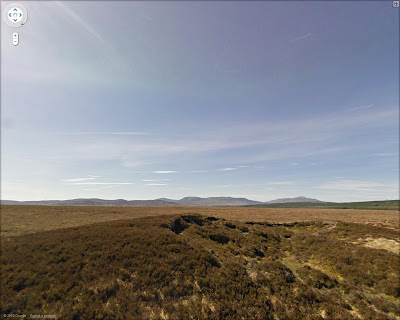The Garvault Hotel in Sutherland claims on its
website to be the remotest hotel in Britain. It's rubbed shoulders with establishments in the Australian Outback and Alaska in a
Forbes magazine remote places to stay survey but even if that seems hard to credit, it's pretty flipping remote.
Not content with being in the middle of nowhere, it's even half a mile down a side road off a road to the middle of nowhere.
And if you turn through 180 degrees from that view above, this is what you see:-
This is what it looks like close up:-
And this is where it is:-
Before I acquired my first car in 1987 (an Alfa Romeo Alfasud reg. USX 9V), I used to pore over Ordnance Survey maps looking for impossibly remote and interesting places to go when I got a car and the Garvault Hotel was very much noted down for future reference. Although I did subsequently acquire a car, and a wife, and we did a lot of motoring round pretty remote country house hotels in the far wild reaches of the country, the Garvault always eluded me - perhaps because it was just too remote. Although when we acquired our first flat and had our first flat warming party, I recall being very intrigued to hear our new neighbour was a regular guest at the Garvault for the fishing: "Oh, at that very remote hotel in Sutherland - does it actually exist, then?" I asked. He was amazed I'd even heard of it.
I have to confess the Garvault Hotel has never crossed my radar since that evening in 1991 until today when I was doing one of my virtual tours round remote parts of Sutherland courtesy of
Google Maps Streetview. I found myself virtually on the B971 approaching Garvault and I thought, surely the hotel won't exist any longer ...
But it does. There don't seem to be any TripAdvisor reviews but there's quite a funny article in the Telegraph you can see
here - scroll about half way down. Here's a taster:-
I enter out of the blinding rain into a bar that for some reason immediately makes me think of the 1970s, in particular the 1970s of Party Seven cans, Double Diamond and New Faces on the TV. The Garvault is run by an English couple, but at first I meet only the husband, Graham. He is cheery in a manner that, were this a film, would presage some terrible event about to happen. 'We wanted to get out of the rat race,’ he explains, and their success seems beyond doubt.
That the Garvault Hotel is remote, we can all agree on, but is it
the remotest in Britain? This is a challenge someone like me with too much time on his hands has to take up.
Now, of course, it depends on how you define "remote" but I'd like to offer as a definition the distance to the next permanently inhabited house. In that case the Garvault Hotel is 4 miles from the houses at Badanloch Lodge. And the nearest village is Kinbrace at 8 miles (admittedly just half a dozen houses but does have a railway station, a primary school and street lights).
I'd like to offer up as a challenger to remotest hotel in Britain, the Cluanie Inn on the A87 from Invergarry to Kyle Of Lochalsh at the head of Glen Shiel:-
Assuming Cluanie Lodge 2 miles away is not permanently inhabited (unless there's a permanent housekeeper in which case I admit defeat), the nearest house to the Cluanie is Achnagart Farmhouse 8 miles west in the direction of Kyle down Glen Shiel. The nearest village is Shiel Bridge 10 miles in the same direction (no station or school but it does have a shop, petrol station and caravan park). Admittedly, there's two little cottages next to the Cluanie but I think they may be staff accommodation. But if they're permanently inhabited independent of the hotel, do leave a comment and I will admit my error.
It also has to be admitted that the Cluanie Inn is beside a double track trunk road to Kyle of Lochalsh and the Isle of Skye whereas the Garvault Hotel is half a mile off a single track road from nowhere to the back of beyond. Judge for yourself.
I stayed at the Cluanie a number of times in the early 90s. The main reason for stopping there was because we could - in other words it served its function of being a wayside inn on a journey which could not be accomplished that day. It was because we were leaving after work from Edinburgh to go to Skye before the bridge and couldn't reach Kyle before the ferry went off for the night. It was very good, the Cluanie in these days, nearly 20 years ago - I hope it still is ...
I seem to have digressed away a bit from whether the Garvault Hotel is Britain's remotest. Do leave a comment defending it or offering other challengers (the Kingshouse on Rannoch Moor perhaps? The house at Altnafeadh's only a couple of miles away ...)
 |
| Garvault - Photo credit MolloF |

























